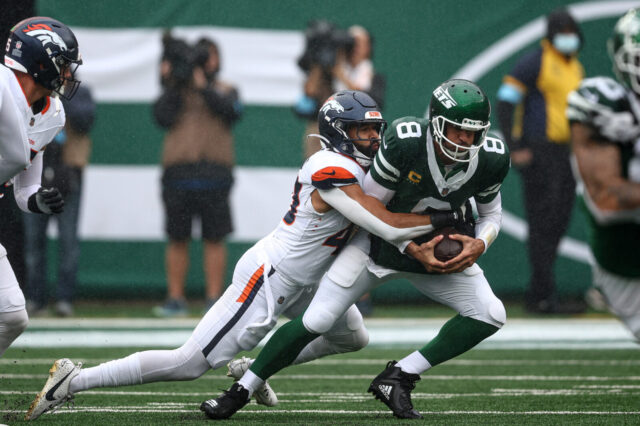The Denver Broncos swung for the fences to solve their quarterback problem in 2022, and wound up striking out.
That said, Nathaniel Hackett’s exit and a strong finish to the season provided more optimism for the future than any other point in the season.
Where do the Broncos stand now that the dust has settled, and where do they go from here? Let’s look.
Russell Wilson
Russell Wilson’s 2023 campaign was nothing short of disastrous and doubled as a referendum on his standing among the league’s elite quarterbacks. The expectations surrounding Wilson have now seismically changed, for the worse, but the post-Hackett era provided some hope that this offense, and Wilson, can at least be functional.
That’s better than anything the Denver Broncos have had since 2014, even if it still falls miles short of meeting Denver’s investment in Wilson.
In 2022, Wilson demonstrated many of the qualities he had shown in the past, just a more degraded version. He was still a high-variance quarterback, as he was throughout much of his Seattle Seahawks career, with his fair share of amazing throws and scrambles that helped to keep the Broncos afloat at times.
But, the flip side of that high-variance style is when you miss on too many deep shots and have a bunch of three-and-outs as a result. Or, you’re holding the ball too long because you’re big-game hunting, and wind up taking a drive-killing sack.
With defenses throwing conservative two-high shell coverages at Wilson at one of the highest rates in the league, those big explosive plays are there less frequently, and, as a result of his declining play-extending ability and struggles operating quick-game concepts, the big negatives are happening more frequently.
2022 saw Russell Wilson post the highest rate of turnover-worthy plays he’s had since 2018 and the lowest rate of big-time throws he’s had in his entire career.
Now, while a lot of that can be pinned on Nathaniel Hackett’s horrific coaching display, it should be noted that even in the post-Hackett era, a lot of Wilson’s problems lingered. Defenses are going to continue to force Wilson to beat them underneath until he proves he can beat them that way, and it’s always been a gap in Wilson’s game, as he struggles to see around the offensive line.
The fact that Russell Wilson got sacked on this play is crazy pic.twitter.com/gDrmohr63J
— Sportsville (@Sportsville_) October 18, 2022
On top of that, it’s even more difficult for Wilson to do that now, because while he is still mobile, he’s not as mobile as he once was, making it more difficult for him to escape the pocket and get all those sight-blocking obstructions out of his way without creating sacks. Too many times this season Wilson was dragged down from behind by a defensive tackle, when a prime Wilson would’ve broken the pocket and created a positive offensive play.
The first 10 dropbacks Wilson had in Week 18 produced a total of three yards for the offense. Over the first half of the Week 17 game, and in the first 29:30 of the Week 18 game, Wilson dropped back to pass 32 times and the offense gained just 91 yards. That’s 59:30 (49.6%) of the 120 post-Hackett minutes.
Even if you give him the entirety of those first halves, he’s still producing worse than Nathan Peterman. Peterman gained 5.12 yards per dropback for his offense while completing 56 percent of his passes. Post-Hackett Wilson gained 4.74 yards per dropback and completed 53 percent of his passes.
Now, in the second halves of those games, Wilson was truly electric. He looked a lot more like the Wilson of old, and he provided the Denver Broncos with a vision of his upside that they hadn’t really gotten in the 16 weeks of Hackett.
Jerry Rosburg and Justin Outten leaned into heavier personnel, minimized the role of the passing game while ensuring they were attacking downfield whenever they did pass it, and leaned on Wilson’s legs more as a way to move the pocket, and also to create plays for an anemic rushing attack. The results speak for themselves, as the offense took terrific leaps across the board, and shouldn’t be fully dismissed.
But, neither should the first halves of those games, where many familiar problems reared their heads.
Rosburg and Outten’s innovations might have been the most important part of the 2022 season for the Denver Broncos, as it made the head coaching job infinitely more appealing and it provided a clear blueprint as to how to help Wilson return to form.
There’s a path to a good Russell Wilson offense out there. The concern is if it will require more supporting assets than what the Broncos can afford, given the price tag associated with the field general.
He’s still got a long way to go before he’s worth his market-setting deal and the blockbuster trade that was swung in order to land him, but there were considerable signs of growth and a lot of good in the final two weeks.
Remembering that it’s not a binary between abhorrent and elite, that a compromise of mediocre exists between those two, and that mediocre still isn’t good enough given the investment that’s been made, will be critical for the health of Broncos Country in the coming years.
Brett Rypien
In 2022, Brett Rypien saw the field more than he had in any other year of his NFL career, to mixed results.
On one hand, Rypien’s limitations were obvious whenever he was at the helm of the offense. He struggled to manage pressure, and he was much worse at protecting the football than Russell Wilson, throwing four interceptions and fumbling the ball four times on top of that. Also, according to Pro Football Focus, he had an additional turnover-worthy throw that wasn’t converted into a turnover.
That’s nine turnover opportunities in 175 snaps (19.4 snaps per), while Wilson had 22 over his 961 snaps (43.7 snaps per).
On the other hand, during the Hackett era, the Denver Broncos’ offense averaged more points, more yards, more points per drive and more yards per drive, while facing the NFL’s 10th-best defense, on average, with Brett Rypien in the lineup. Wilson faced the NFL’s 20th-best defense on average during the Hackett era.
Now, the post-Hackett bump flips those stats in favor of Wilson, but we also didn’t get to see Rypien after Hackett’s incompetence was removed from the picture.
This isn’t to say that Rypien is better than Wilson either. He’s not. That’s why this is so concerning. Why did the offense produce better with Rypien, a low-tier backup, than it did with Wilson, a supposed superstar quarterback being paid to be elite at his position? Why was the run game wildly more efficient? These are questions the Walton Penner Group and Co. should try and answer this offseason during their soul searching.
The last aspect of the Rypien conversation is that, while he’s an adequate backup quarterback, the Denver Broncos might want to search for someone at the position who could take over as starting quarterback and potentially keep the season alive, in the event that Wilson returns to form in 2023.
Wilson’s strong close to the season makes that need a little less dire, but it’s still something the Broncos should consider. If the rest of the roster makes a bigs leap under strong coaching — a la what we saw from Jacksonville when they went from Urban Meyer to Doug Pederson this season — and if Wilson fails to make that leap, or somehow shows further regression, it would be nice if the Broncos had a Jacoby Brissett-type to turn to.
Jarrett Guarantano
Jarrett Guarantano was signed to the Arizona Cardinals’ 90-man roster this summer, as an undrafted free agent out of Washington State, and after spending some time on Arizona’s practice squad, the Denver Broncos signed him to their own practice squad in December, to replace Josh Johnson.
Guarantano has yet to play an NFL snap, and while he’s under contract for 2023 and could hold onto his practice squad spot, he’s not immune to the uncertainty surrounding Denver’s quarterback room.
If the Denver Broncos look to find a backup with starting upside, and Rypien gets bumped down the depth chart, Guarantano could find himself without even a practice squad spot.



